Related Research Articles
The Battle of Mactan was fought on a beach in Mactan Island between Spanish forces led by the Portuguese explorer Ferdinand Magellan along with local allies, and Lapulapu, the chieftain of the island, on the early morning hours of April 27, 1521. Magellan, a Portuguese-born commander serving the Spanish Empire who led an expedition that ultimately circumnavigated the world for the first time, commanded a small Spanish contingent in an effort to subdue Mactan under the Spanish crown. The sheer number of Lapulapu's forces, compounded with issues associated with the location and the armor, ultimately resulted in a disastrous defeat to the Europeans and the death of Magellan. Surviving members of Magellan's crew continued the expedition under the command of Juan Sebastian de Elcano, who completed the journey in September 1522.
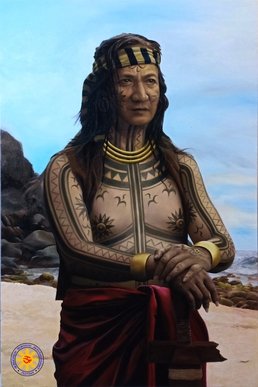
Lapulapu or Lapu-Lapu, whose name was first recorded as Çilapulapu, was a datu (chief) of Mactan, an island now part of the Philippines. Lapulapu is known for the 1521 Battle of Mactan, where he and his men defeated Spanish forces led by Portuguese explorer Ferdinand Magellan and his native allies Rajah Humabon and Datu Zula. Magellan's death in battle ended his voyage of circumnavigation and delayed the Spanish occupation of the islands by over forty years until the expedition of Miguel López de Legazpi in 1564.

Duarte Barbosa was a Portuguese writer and officer from Portuguese India. He was a scrivener in a feitoria in Kochi, and an interpreter of the local language, Malayalam. Barbosa wrote the Book of Duarte Barbosa c. 1516, making it one of the earliest examples of Portuguese travel literature.

Magellan's Cross Pavilion is a stone kiosk in Cebu City, Philippines. The structure is situated on Plaza Sugbo beside the Basilica del Santo Niño. It houses a Christian cross that was planted by explorers of the Spanish expedition of the first circumnavigation of the world, led by Ferdinand Magellan, upon arriving in Cebu in the Philippines on April 21, 1521.

Limasawa, officially the Municipality of Limasawa, is an island municipality in the province of Southern Leyte, Philippines. According to the 2020 census, it has a population of 6,191 people, making it the least populated town in the province.

The Señor Santo Niño de Cebú is a Catholic title of the Child Jesus associated with a religious image of the Christ Child widely venerated as miraculous by Filipino Catholics. It is the oldest Christian artifact in the Philippines, originally a gift from the Conquistador Ferdinand Magellan to Rajah Humabon and his wife and chief consort, Hara Humamay on account of their Christian baptism in 1521. The image is the only canonically crowned image of Jesus Christ in the Philippines.
Datu Daya was a legendary lord of Kandaya, the place that is now known as Daanbantayan, Cebu, in the Philippines.
Rajah Humabon later baptized as Don Carlos Valderrama, was one of the recorded chiefs in Cebu who encountered Ferdinand Magellan in the 16th century. Humabon ruled at the time of the arrival of Portuguese-born Spanish explorer Ferdinand Magellan in the Philippines in 1521. Humabon, his wife, and his subjects were the first known Christian converts in the Philippines. However, since there were no Catholic priests in Cebu from 1521 to 1565, this Christianity was not practised until the return of the Spaniards to Cebu. There is no official record of Humabon's existence before the Spanish contact. The existing information was written by Magellan's Italian voyage chronicler, Antonio Pigafetta on Humabon and the indigenous Philippine peoples that existed prior to Spanish colonization. Rajah Humabon is cited as the reason for why Magellan fought in the Battle of Mactan, as the latter wanted to earn the trust of Humabon by helping him subdue his opponent Lapulapu, one of the chiefs of Mactan. Despite being referred to as "king" in the journal of Antonio Pigafetta, he was not one like in the manner of a monarch in centralized societies, it is plausible that the title was mistakenly applied because according to succeeding chroniclers, there were no kingdoms in the pre-colonial Philippines.
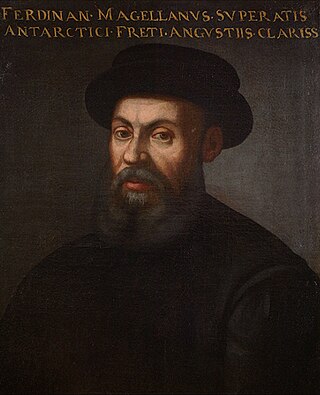
Ferdinand Magellan was a Portuguese explorer best known for having planned and led the 1519–22 Spanish expedition to the East Indies. During this expedition, he also discovered the Strait of Magellan, allowing his fleet to pass from the Atlantic into the Pacific Ocean and perform the first European navigation to Asia via the Pacific. Magellan died in the Philippines during his voyage, and his crew commanded by the Spanish Juan Sebastián Elcano completed the return trip to Spain in 1522 achieving the first circumnavigation of Earth in history.
The Treaty of Cebu is a peace treaty signed on June 4, 1565 between Miguel López de Legazpi, representing King Philip II of Spain, and Rajah Tupas of Cebu. The treaty effectively created Spanish suzerainty over Cebu and started the Spanish colonization of the Philippines until 1898.
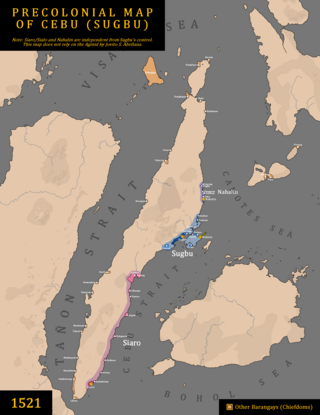
Cebu, also called Sugbu, sometimes called the Rajahnate of Cebu, was an Indianized monarchy mandala (polity) on the island of Cebu in the Philippines prior to the arrival of the Spanish conquistadors. It is known in ancient Chinese records as the nation of Sokbu (束務) (Hokkien) or Suwu (Mandarin). According to Visayan oral legend, it was founded by Sri Lumay or Rajamuda Lumaya, a half-Malay and half-Tamil from Sumatra. The capital of Cebu was Singhapala which is Tamil-Sanskrit for "Lion City", the same root words with the modern city-state of Singapore.

The Magellan expedition was the first voyage around the world in human history. It was a Spanish expedition that sailed from Seville in 1519 under the initial command of Ferdinand Magellan, a Portuguese sailor, and completed in 1522 by Spanish Basque navigator Juan Sebastián Elcano.

The first documented Catholic Mass in the Philippines was held on March 31, 1521, Easter Sunday. It was conducted by Father Pedro de Valderrama of Ferdinand Magellan's expedition along the shores of what was referred to in the journals of Antonio Pigafetta as "Mazaua".

Singhapala was an ancient fortified city or a region, the capital of the Indianized kingdom of Cebu. The location of this ancient city is what is now the modern Barangay Mabolo in the northern district of Cebu City. It was founded by Sri Lumay or Raja Muda Lumaya, a half-Tamil and half-Malay from Sumatra.
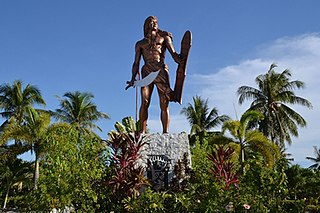
Mactan Shrine, also known as Liberty Shrine or Lapulapu Monument, is a memorial park on the island of Mactan in Lapu-Lapu City, Philippines. It hosts two monuments, namely the Magellan Monument, which is dedicated to Portuguese explorer Ferdinand Magellan and the Lapu Lapu Monument, a bronze statue which commemorates Lapu Lapu, a native leader who defeated Spanish soldiers led by Magellan in the 1521 Battle of Mactan.
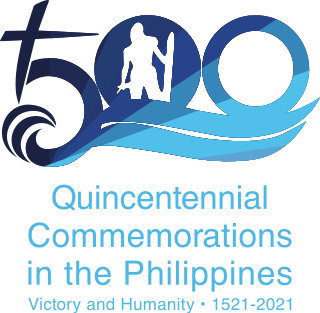
The 2021 Quincentennial Commemorations in the Philippines was a series of observances organized to mark the 500th anniversary of various events in the Philippines, notably the introduction of Christianity in the Philippines, the role of the country in the Magellan–Elcano circumnavigation, and the victory of Lapulapu in the Battle of Mactan.
Rajah Siawi was the ruler of Butuan and Calaga (Surigao) during the arrival of Ferdinand Magellan in Limasawa Island. A cousin of Rajah Humabon of Cebu, Rajah Siawi was one of the first rulers to accept Christianity and attend the first Catholic mass in the Philippines.

1521 is a 2024 historical drama film written by Mary Krell-Oishi and directed by Michael Barder. It stars Danny Trejo, Bea Alonzo, Costas Mandylor, Michael Copon, Hector David Jr., Maricel Laxa, Vic Romano, Floyd Tena, Larissa Buendia. The film is about the battle of Lapu-Lapu and Ferdinand Magellan in Mactan, Cebu and about the love story of a native princess and a Spanish soldier.
References
- ↑ "Magellan, the first diplomat". Manila Bulletin. Retrieved 2024-06-21.
- ↑ Angeles, Jose Amiel. "The Battle of Mactan and the Indigenous Discourse on War." Philippine Studies vol. 55, No. 1 (2007): pp. 3-52.
- ↑ "The Death of Magellan, 1521". Archived from the original on 7 June 2008. Retrieved 9 June 2008.